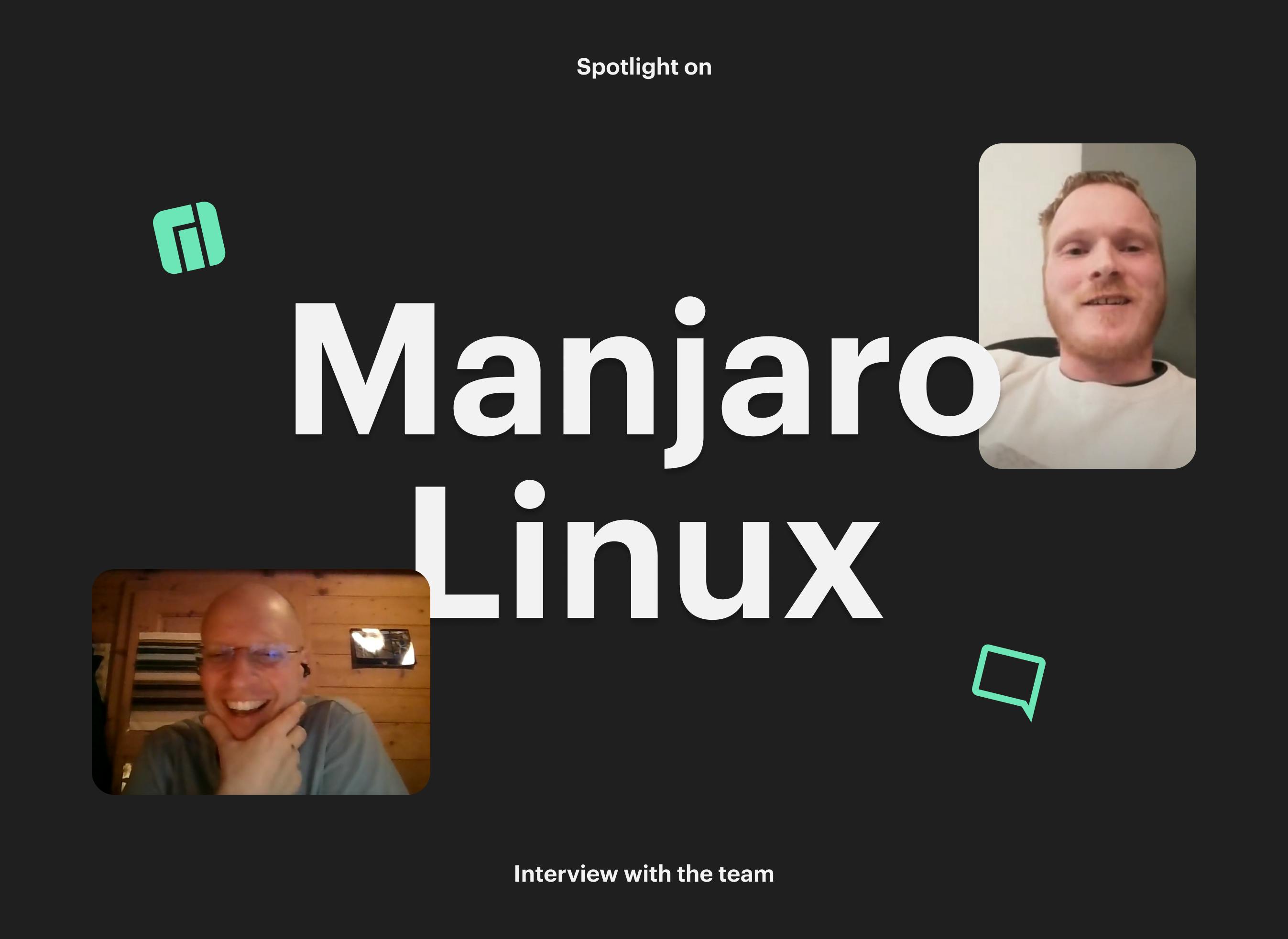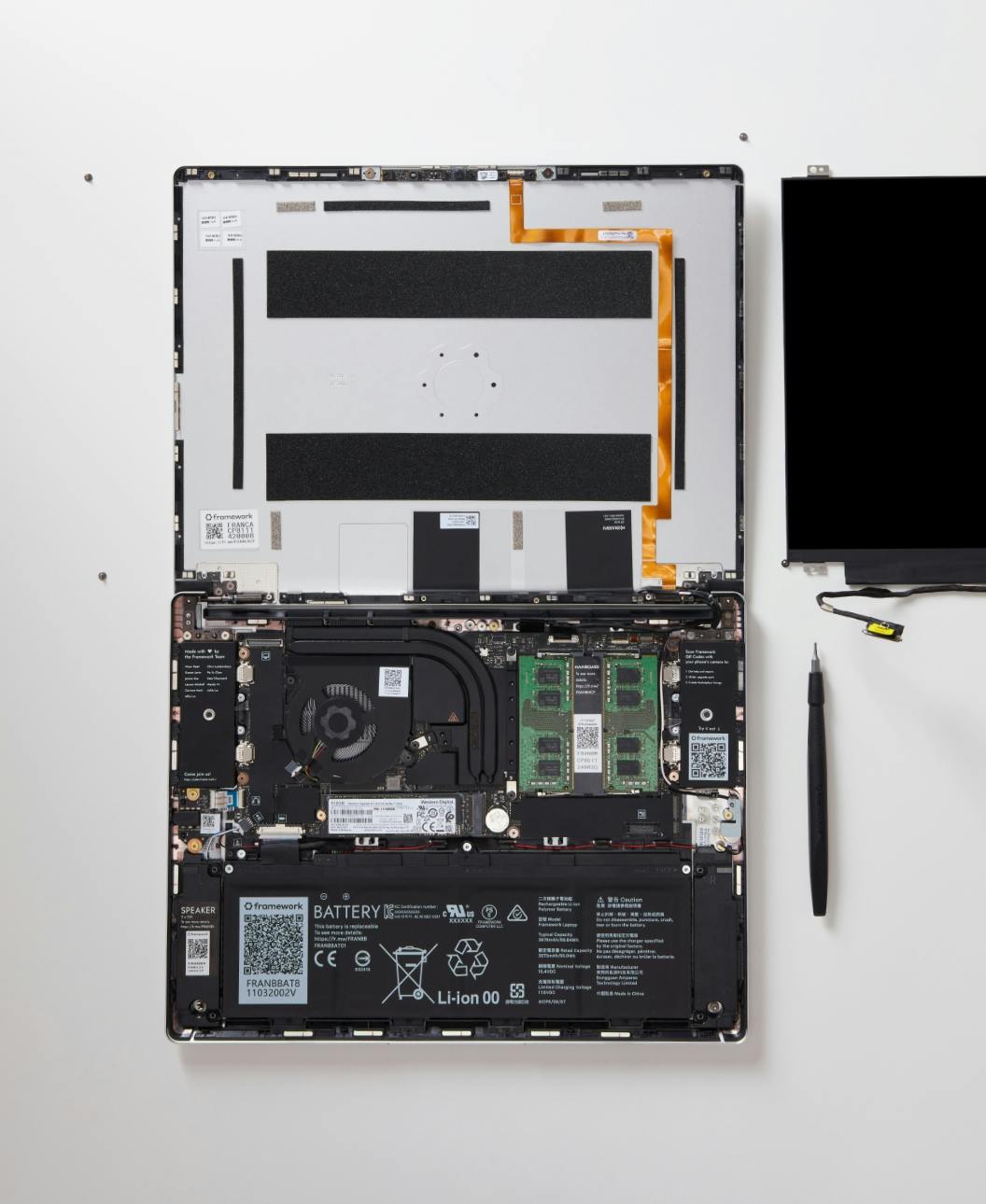Spotlight on Manjaro Linux: Interview with the team

The Framework Laptop is about choice, whether that is customizing your ports, deciding when and how to upgrade parts, or picking your preferred Operating System. The Framework Laptop DIY Edition comes without an OS pre-installed, making it easy to bring your favorite Linux distribution if you’d like. We’ve seen a large number of users choose Linux, and we’re continuing to focus on making Linux support as seamless as possible. We’ve published a page with recommended distributions, shared step-by-step setup guides, and recently hired a Linux Support Lead to interface with the community and improve documentation. In addition, we’re building direct relationships with the teams leading major Linux distributions.
In a previous blog post, we interviewed Matthew Miller, a Fedora project leader, to learn more about Fedora on the Framework Laptop. Now, we’re interviewing Manjaro’s Project Leader, Philip Müller, Co-lead Developer, Bernhard Landauer, and Lead Web Developer, Vitor Lopes. Manjaro is a popular Linux distro choice for Framework Laptop users, and is a streamlined and reliable way to get access to the Arch ecosystem. In the following interview, we will learn more about Manjaro, discover the Manjaro team’s experience with the Framework Laptop, and get their thoughts on recommended Manjaro Editions for Windows and MacOS users who are looking to transition into a Linux-based environment.
How did you get into your current roles at Manjaro?
Philip: I was in the Arch forum and I saw there was this post by Roland Singer and he said he was doing a new project called Manjaro and back then it was just an installer for Arch and I looked at it and I disliked it. So I said, hey I have a better idea for that. We realized we were located near each other, only 20 km away, and so we met in person. We drank a cup of tea together, and we decided everything, and soon we had a small team in Germany.
Bernhard: I started as a user, coming over from Windows. But Windows was never the right thing for me because I always wanted to go below the surface. I started in the community, contributing little things, translations to start, and then also I picked up some Community editions. Of course, Manjaro has the main editions, in the early days it was just XFCE and Plasma and now it’s also GNOME but back then I picked up i3 because I wanted to go to the total opposite of Windows, with only text and a few frames. I realized the Cinnamon Edition had been abandoned, and I picked that up as well because I really thought it was a brilliant desktop. And also the Deepin project came about and it looked really interesting with really cool design, but wasn’t working properly on Arch-based distributions so I invested a lot of time and energy on that one. I got more and more involved so Philip and I got to know each other more. I’m not a programmer or a computer guy from the beginning, but I’ve always been interested in learning and trying out new things and somehow I ended up here.
Vitor: I came from a Windows user background as well. I was looking for an operating system to do my web development stuff. I tried some different ones, openSUSE and I tried Fedora, but in the end I ended up settling on Manjaro because of the rolling release. I remember I started doing some experiments at the time, with a desktop environment I was building using HTML and I posted it in the forum and Philip saw it and that’s how we started working together. Now I help Philip with the servers, I work on the website, and I do some packaging if needed.
Tell us more about Manjaro and why someone new to this distribution might want to consider it?
Philip: We have a package manager, like a software store, so you can open up the application, you can look up what software you’re searching for like a web browser, a text editor, games, and stuff like that. The store also supports flatpaks, which is a new type of way to distribute packages. So, you have one big package that has all the dependencies and libraries so the application can work. Then there’s another one called Snaps which comes from Canonical. I actually went to the Snapcraft Summit in Vancouver, so I met with Canonical guys and in that week I was able to get their packaging support integrated into Manjaro and they were all stoked. And since then we have been good friends with Canonical. The latest feature we added, which will come next year, is an automatic download of the packages. You can work on your machine all day, select what software you want, update on the session if you want, or if you shut down, the updates you have in queue will install and the next day you’ll have a fresh system. We’re just testing this right now. We also have graphical tools where you can change the version of the kernel, which is the main core of the linux system which has drivers, the graphic cards, audio support and network support included. With us, you can have every version of the kernels available, from the oldest ones to the newest latest and greatest in development. We made it easy to have all the software and all settings easily available.
Bernhard: For people it’s very tempting to use a bleeding-edge distribution, and because of that many people are drawn to Arch Linux, but the drawback is that it’s extremely difficult to install, you need to do everything from the start. You need to install all your drivers, figure out all the hardware problems, and Manjaro solves a lot of these issues with our hardware detection tool, which installs all the needed drivers for you so you have a very easy install. This way you can use all the benefits of Arch Linux, with the latest software, and access to the Arch User repository without going the hard way of installing an Arch-linux based system.
Would you consider Manjaro to be a good Linux distribution for beginners?
Bernhard: It’s something in between the easiest-to-use interfaces and the customize-everything-yourself distributions. You need to work on it a bit, but we try to assist the user. Normally our install media is ready to go and ready to use for everyday needs. It may need some intervention sometimes, but we are trying to avoid that.
We really try to offer a ready-to-go beautifully designed interface. We have our set of usual colors, everything is green, which some people hate and some people love. But the point is, it looks nice from the start, you can use it, you can change everything, which is kind of the Linux philosophy.
Vitor, you received a Framework Laptop (11th Gen Intel Core) and Bernhard, you received a Framework Laptop (12th Gen Intel Core) for Linux testing. What are your thoughts on the Framework Laptop?
Vitor: I made my Framework my main laptop and I’m using it right now. I’m really happy with it. I opened it up inside and it looks amazing. It’s so easy to disassemble and you can even use the other ports for other laptops if you need to.
Bernhard: Yours came already assembled right?
Vitor: Mine came already assembled, yeah.

Bernhard: Ah, mine was like the Ikea experience putting it together, which I loved. I love that you can switch the ports, my plug is always on the wrong side but with this laptop you can just switch it and now my plug can reach. I really love that. It’s also really light and I really love the glossy screen, which some people don’t like, but I like it. Yeah, it’s perfect. I’m really impressed.
Vitor: Something else I liked is the screws. When you open the screws they don’t fall. And that is great because I always unscrew something and it falls on the floor.
Bernhard: Yeah I always have the experience where when I take a machine apart and put it back together, I always have one screw too many.
Vitor: Same here, Bernhard. Same here.
Bernhard: And this approach, even including the screwdriver, it’s just an awesome Linux machine.
How was your experience installing Manjaro on the Framework Laptop?
Bernhard: I think for Vitor everything just worked, right?
Vitor: It’s just the fingerprint reader at the moment. It works on GNOME on the GUI only, if you want to use KDE you have to go on the command line. They are working on that upstream and you can see they have the GUI for the fingerprint sensor, but it doesn’t work yet. I am hopeful it will get fixed.
Bernhard: I received the newer generation [12th Gen], and the only minor thing I had was the brightness controls which needed a blacklist. But this is a problem with the Linux kernel, so I just blacklisted it and it works totally fine. Apart from that, it’s extremely fast. I have a Ryzen 9 that I regularly use and I compared them. I had a stopwatch and I was compiling on both and the Framework Laptop was significantly faster. It was really impressive.
What type of Manjaro desktop environment would you recommend for a Windows user and a MacOS user to have the best experience?
Philip: I think for Mac users, GNOME Edition. And if you don’t like GNOME, maybe Budgie or Mate. Those are the three that are closest to MacOS. I would say XFCE for old Windows users. They want it to work and don’t care how it looks. KDE for Windows users that want to change everything under the moon. And GNOME for the rest. And everything else is there, you still have it, you can test it out, we have live sessions to experience it, and if something else is there you want to try out, then simply go for it.
Matt Hartley (Framework Linux Lead): Yeah, I definitely feel like XFCE and Mate, for Windows users especially are like oh! Launcher, menus, I feel right at home.
Bernhard: And even though it’s a community edition, Cinnamon is very similar to the older Windows versions, where I felt at home a lot. It also has a very similar menu. So it’s not an official edition, but it’s still maintained by me, although I don’t have so much time for it at the moment. But it’s working and it’s a very popular edition. It’s very Windows-y.
How does package review work, in that how do you all review your packages before they’re released to the general public?
Bernhard: It’s not organized in a strict way, but the community has grown to a point where problems get solved. We don’t have a specific user count since we don’t count or identify users, so it’s just an estimate but, even on our unstable branch, which is supposed to be the smallest user base, if I update a kernel and I forget a module or something then it normally takes a few minutes before someone will complain, which shows that lots of users are using all the branches. So I will release a package on the unstable branch, people in the community will run it, test it, let us know if they have problems, and most of the time we’ll be able to fix it before we ship it to the testing branch. So it basically just works via community using the branches and giving feedback about their experience.
Matt: Would you say that differs from other distributions?
Bernhard: It’s like walking the tightrope between bleeding edge and having something where you have to hold back packages for months. It’s a compromise we find. It works because the community is big enough. If a few developers had to test every package in every environment it just wouldn’t work.
Matt: Yeah, I’ve been on the testing side of things for distributions and it just wouldn’t happen. And sometimes you’ll see that waterfall effect where as you’re breaking it you’ll see other testers experiencing the same thing which is both gratifying and terrifying.
Bernhard: Yes, it keeps amazing me.
If anyone reading this has questions about Manjaro, where should they reach out for support?
Easiest is the Manjaro Linux forum, always. The forum is the best. There are lots of people there all around the clock. Go there and your concerns will be directed in the right direction. The forum has been our strength for many years.
Linux on the Framework Laptop
If you’re interested in installing Linux on your Framework Laptop, check out our compatibility page to see what distros we’ve tested to be fully functional out of the box, or see our guides such as the Manjaro 21.3.1 Installation guide to get you started with your Framework Laptop.
